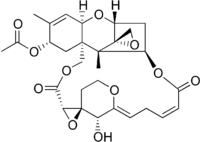- Myrotoxin B
-
Myrotoxin B 
Identifiers CAS number 99486-49-4 PubChem 6540635 Jmol-3D images Image 1 - CC1=C[C@]2([H])[C@]([C@@](C)3[C@]4(CO4)[C@@]([H])(C[C@H]3OC5=O)O2)(CO[C@]([C@@H](O7)[C@]([C@H]/6O)7CCOC6=C/C/C=C\5)=O)C[C@@H]1OC(C)=O
Properties Molecular formula C29H34O11 Molar mass 558.57 g mol−1 Melting point 195-197 °C[1]
 B (verify) (what is:
B (verify) (what is:  /
/ ?)
?)
Except where noted otherwise, data are given for materials in their standard state (at 25 °C, 100 kPa)Infobox references Myrotoxin B is a macrocyclic trichothecene first isolated in 1985.[1] It was tested on Swiss mice and found to be very toxic, though not the most toxic of the three toxins that were tested at that time.[2] It has also been isolated from Myrothecium roridum, a pathogen leaf spot that affects mulberry, though it is unknown if it is used as a pathotoxin.[3]
References
- ^ a b Jarvis, Bruce B.; Lee, Yin Won; Comezoglu, F. Taha; Comezoglu, S. Nilgun; Bean, George A. (1985). "Myrotoxins: a new class of macrocyclic trichothecenes". Tetrahedron Letters 26 (40): 4859–62. doi:10.1016/S0040-4039(00)94970-0.
- ^ Schiefer, Hb; Hancock, Ds; Jarvis, Bb (Feb 1989). "Toxicology of novel macrocyclic trichothecenes, baccharinoid B4, myrotoxin B, and roritoxin B.". Zentralblatt fur Veterinarmedizin. Reihe A 36 (2): 152–60. ISSN 0514-7158. PMID 2501953.
- ^ Murakami Ritsuko; Shirata, A. (2005). "Myrotoxin B detection from mulberry leaves infected with Myrothecium roridum, cause Myrothecium leaf spot of mulberry, and possible roles in pathogenicity". Japanese Journal of Phytopathology 71 (2): 91–100. doi:10.3186/jjphytopath.71.91. http://sciencelinks.jp/j-east/article/200514/000020051405A0510346.php.

This article about an organic compound is a stub. You can help Wikipedia by expanding it.
